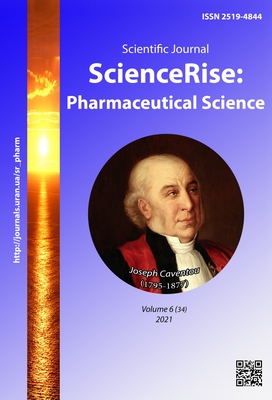Ідентифікація бензидаміну та його метаболіту в присутності деяких протизапальних нестероїдних препаратів
DOI:
https://doi.org/10.15587/2519-4852.2021.249634Ключові слова:
бензидаміна гідрохлорид, скринінг, бензидаміну N – оксид, тонкошарова хроматографія, високоефективна рідинна хроматографіяАнотація
Мета роботи. На теперішній час описана велика кількість випадків немедичного застосування бензидаміну гідрохлориду. Ідентифікація бензидаміну та його метаболіту – N-оксиду бензидаміну, в присутності деяких нестероїдних протизапальних засобів вивчена недостатньо. Тому розробка методу його ідентифікації в біологічному матеріалі є актуальним завданням.
Матеріали та методи. Предметами дослідження були бензидаміну гідрохлорид та його метаболіт, а також деякі нестероїдні протизапальні засоби, що є його аналогами за фармакологічною дією. Дослідження проводили методами тонкошарової хроматографії та високоефективної рідинної хроматографії.
Результати. На першому етапі вивчено скринінговий метод ідентифікації бензидаміну з використанням екстракції в кислих і лужних умовах. Показано, що бензидамін можна виділити в обох середовищах, з подальшим проявом розчином йодоплатината та реактивом Драгендорфа за Мюньє або реактивом Манделіна відповідно. Була обрана рухома фаза для розділення та визначено відповідний hRf для цільової молекули.
Після попередньої ідентифікації бензидаміну було запропоновано метод остаточного підтвердження речовини. Було обрано надійний, специфічний і точний метод ВЕРХ з оберненою фазою. Показано, що бензидамін знаходиться в біологічному матеріалі переважно у формі метаболіту – N-оксиду бензидаміну. Обраний метод дозволив розділити та визначити ключові аналіти в біологічних зразках після препаративного виділення методом тонкошарової хроматографії. Запропоновано порівняння з УФ-спектрами еталонного стандарту бензидаміну гідрохлориду, щоб уникнути хибнопозитивного висновку про ідентифікацію лікарського засобу.
Висновки. Запропонована методика може бути використана для рутинної ідентифікації отруєнь бензидаміном у токсикологічних лабораторіях
Посилання
- Gunaydin, C., Bilge, S. S. (2018). Effects of Nonsteroidal Anti-Inflammatory Drugs at the Molecular Level. The Eurasian Journal of Medicine, 50 (2), 116–121. doi: http://doi.org/10.5152/eurasianjmed.2018.0010
- Kuriyama, A., Aga, M., Maeda, H. (2018). Topical benzydamine hydrochloride for prevention of postoperative sore throat in adults undergoing tracheal intubation for elective surgery: a systematic review and meta-analysis. Anaesthesia, 73 (7), 889–900. doi: http://doi.org/10.1111/anae.14224
- Sein Anand, J., Lukasik-Glębocka, M., Paweł Korolkiewicz, R. (2007). Recreational abuse with benzydamine hydrochloride (tantum rosa). Clinical Toxicology, 45 (2), 198–199. doi: http://doi.org/10.1080/15563650600981210
- Reed, P. (2017). Sussex research reveals the addictive potential of a drug legally available in the UK and other countries. University of Sussex. Available at: https://www.sussex.ac.uk/broadcast/read/40139
- Opaleye, E. S., Noto, A. R., Sanchez, Z. van der M., Moura, Y. G. de, Galduróz, J. C. F., Carlini, E. A. (2009). Recreational use of benzydamine as a hallucinogen among street youth in Brazil. Revista Brasileira de Psiquiatria, 31 (3), 208–213. doi: http://doi.org/10.1590/s1516-44462009000300005
- Mota, D. M., Costa, A. A. da, Teixeira, C. dos S., Bastos, A. A., Dias, M. F. (2010). Use abusive of benzydamine in Brazil: an overview in pharmacovigilance. Ciência & Saúde Coletiva, 15 (3), 717–724. doi: http://doi.org/10.1590/s1413-81232010000300014
- Balaban, O. D., Atagun, M. I., Yilmaz, H., Yazar, M. S., Alpkan, L. R. (2013). Benzydamine Abuse as a Hallucinogen: A Case Report. Klinik Psikofarmakoloji Bülteni-Bulletin of Clinical Psychopharmacology, 23 (3), 276–279. doi: http://doi.org/10.5455/bcp.20111212083751
- Can, B., Oz, I., Ozer, H., Simsek, T. (2016). Hallucinations after Ingesting a High Dose of Benzydamine Hydrochloride. Clinical Psychopharmacology and Neuroscience, 14 (4), 407–408. doi: http://doi.org/10.9758/cpn.2016.14.4.407
- Acar, Y. A., Kalkan, M., Çetin, R., Çevik, E., Çınar, O. (2014). Acute Psychotic Symptoms due to Benzydamine Hydrochloride Abuse with Alcohol. Case Reports in Psychiatry, 2014, 1–2. doi: http://doi.org/10.1155/2014/290365
- Gürü, M., Şafak, Y., Cengiz, G. F., Kuru, E., Örsel, S. (2019). Chronic psychosis related to benzydamine hydrochloride abuse. Neurocase, 25 (3-4), 156–158. doi: http://doi.org/10.1080/13554794.2019.1617318
- Schifano, F., Corazza, O., Marchi, A., Melchiorre, G. D., Sferrazza, E., Enea, A. et. al. (2013). Analysis of online reports on the potential misuse of benzidamine. Rivista di Psichiatria, 48 (3), 182–186. doi: http://doi.org/10.1708/1292.14286
- Robinson, N. A., Scully, C. (2016). Oral health: Mouthwash abuse. British Dental Journal, 221 (6), 280–280. doi: http://doi.org/10.1038/sj.bdj.2016.663
- Chiappini, S., Guirguis, A., Corkery, J. M., Schifano, F. (2020). Misuse of prescription and over-the-counter drugs to obtain illicit highs: how pharmacists can prevent abuse. Pharmaceutical Journal. doi: http://doi.org/10.1211/pj.2020.20208538
- Pubchem. Benzydamine (Compound). Available at: https://pubchem.ncbi.nlm.nih.gov/compound/12555#section=Information-Sources
- Naser, I. (2006). Izuchenie khromatograficheskogo povedeniia valproevoi kisloty v smesi s drugimi veschestvami kislogo kharaktera. Teorіia ta praktika sudovoi ekspertizi і krimіnalіstiki, 6, 302–305.
- Nasser, I. (2008). Rozrobka metodiv analitychnoyi diahnostyky otruyen valproyevoyu kyslotoyu. Kyiv, 163.
- Catanese, B., Lagana, A., Marino, A., Picollo, R., Rotatori, M. (1986). HPLC determination of benzydamine and its metabolite N-oxide in plasma following oral administration or topical application in man, using fluorimetric detection. Pharmacological Research Communications, 18 (4), 385–403. doi: http://doi.org/10.1016/0031-6989(86)90091-3
- Cherniy, V. A., Gureeva, S. N., Georgiyants, V. A. (2016). Development and Validation of Alternative Analytical Method for Determination of Related Substances of Benzydamine Hydrochloride in Oral Spray by HPLC. Journal of Drug Design and Medicinal Chemistry, 2 (6), 65–73.
- Chornyi, V., Chorna, O., Georgiyants, V. (2020). Development and validation of the method for simultaneous determination of Benzydamine hydrochloride and methylparaben in dosage form by HPLC. ScienceRise: Pharmaceutical Science, 3 (25), 12–19. doi: http://doi.org/10.15587/2519-4852.2020.206579
- Moffat, A. C., Osselton, M. D., Widdop, B. (2011). Clarke’s Analysis of Drugs and Poisons. Pharmaceutical Press, 2736.
##submission.downloads##
Опубліковано
Як цитувати
Номер
Розділ
Ліцензія
Авторське право (c) 2021 Olga Chorna, Vasyl Chornyi, Oleksandr Сhubenko, Ihor Hrubnyk, Volodymyr Mishchenko

Ця робота ліцензується відповідно до Creative Commons Attribution 4.0 International License.
Наше видання використовує положення про авторські права Creative Commons CC BY для журналів відкритого доступу.









